The Best B2B (Battery To Battery) Chargers
When driving around, your van is producing massive amounts of electricity from the alternator which can be used to charge your leisure batteries.
A B2B charger is the most effective tool for this job because it creates a multi-stage charge for the leisure batteries from the simple system voltage provided by the alternator.
- Very simple to install
- 100% fire proof plastic box
- Multi stage fan cooling
- High-power
- Waterproof
- Regenerative braking and manual override ability
- Automatically selects most efficient source
- Can be connected directly to solar panels
- Multi-step charging
- Draw power from solar and wind sources
- Automatic battery separator
- Selectable AGM mode
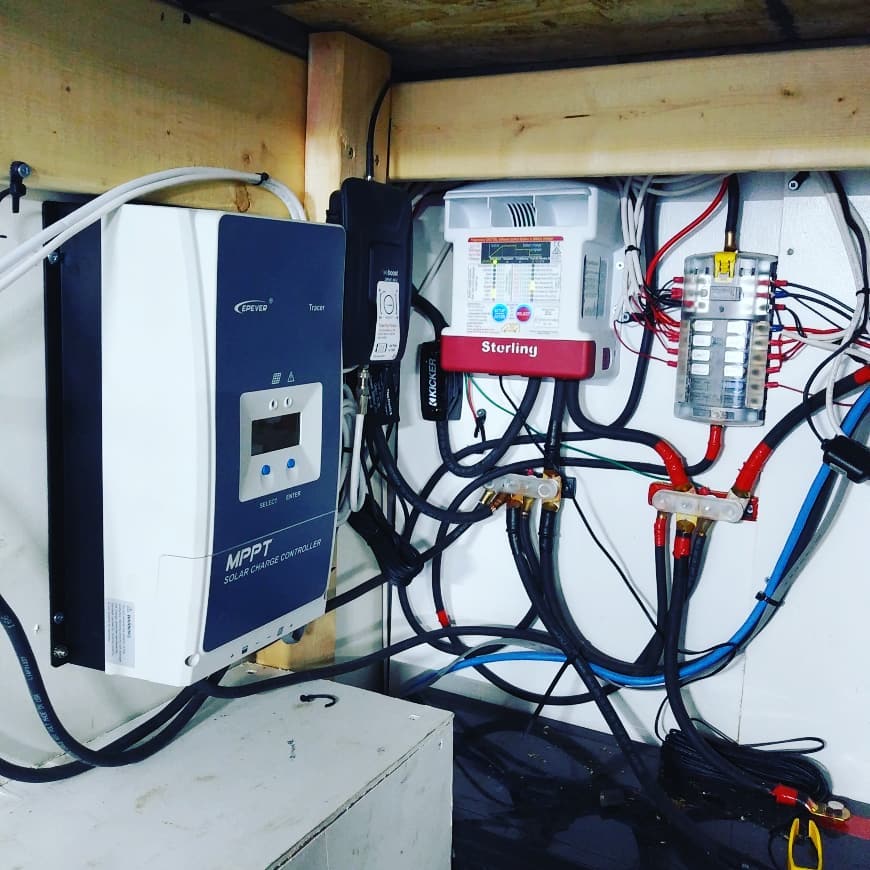
B2B Charger vs Battery Isolator
Battery isolators essentially pair the leisure batteries with your existing vehicle electrical system so that the alternator thinks it’s just charging a bigger starter battery. This is a simple way to grab power and functions fine at a relatively low cost.
Where isolators falls short is they don’t provide a full multi-stage charge to your leisure battery.
Because of system resistances and the voltage that the starter battery is charged, isolators will charge your system relatively slowly when filling the leisure batteries the last bit of the way up. This is because an alternator is designed to keep a starter battery topped off, not recover it from deep discharge. It provides charge based on the system resistance when running which slows down as the batteries get more full. Once the leisure batteries are charged up to 80% or so, the alternator output will be at a trickle charge- sometimes less than 5A.
A B2B charger resolves these issues. A B2B charger uses the same energy from the alternator – but more of it and in a more efficient way.
B2B chargers all work essentially the same: They connect to the starter battery and pull as much power from it as they safely can. This makes the alternator work harder to keep up with the power draw, similar to turning on a bunch of lights and stereo in your car would. The B2B charger then takes this power and steps up the voltage – which remember is coming int at about 13.8V – and increases it to appropriate fast absorption rates for your leisure batteries. The real power and efficiency of a B2B charger comes from this step in the process.
All good B2B chargers will make sure that your starter battery doesn’t get drained faster than the alternator is charging it. This is done by limiting the voltage drop – usually to around 13.1V to make sure the starter battery stays topped off.
If you can afford the up-front cost and are relying on electricity to function on the road, a B2B charger is one of the first pieces you should upgrade from a standard isolator in your system.
Which B2B Charger Should You Get:
The US market has pretty limited options for B2B chargers. There are only two readily accessible companies with a few different combinations of products to consider. Fortunately, both are very reputable and there are options for all system sizes.
These all work in a similar way. They are attached directly to your starter battery. They don’t turn on until the system voltage reaches charging levels (so they won’t drain your starter when the car is off). This ensures that the alternator is still charging the starter battery but maximizes the amount of energy that the B2B gets from the alternator.
| Sterling BB1230 | Sterling BB1260 | Sterling BBW12120 | CTEK D250SA | CTEK D250SA+Smartpass | |
|---|---|---|---|---|---|
| Input Charge Rating | 30A | 60A | 120A | 20A | 140A |
| Built-in Solar MPPT | YES, up to 20A, 12V (~450W) | YES, up to 20A, 12V (~450W) | |||
| Lead Acid Battery Size | 300Ah | 300-600Ah | 400-800Ah | 100-200Ah | 800Ah |
| LiFePO4 Charging | ✓ | ✓ | ✓ | ||
| Water Resistance | Low- IP21 | Low- IP21 | Very High- IP68 | High- IP65 | High- IP65 |
| Battery Temp Sensor | ✓ | ✓ | ✓ | ✓ | ✓ |
| Remote Monitor | Optional | Optional | Optional | ✓ | |
| Cost | $$ | $$$$ | $$$$$$ | $$ | $$$$$$$$ |
| Installation Manual | |||||
| Price | Check Price | Check Price | Check Price | Check Price | Check Price |
If you don’t see a system that you like, look at the options offered by Redarc and Ablemail Electronics. These are less common in the U.S. but quite reputable overseas.
Things To Look For In A B2B Charger
Input Charge Rating
This is the max amount of charge the system can take from your starter battery. The output will vary slightly based on the voltages being set for multi stage processing. But it is fine to connect a 30A charger to a system with a 120A alternator- it won’t cause any problems.
Built-In Solar
The CTEK unit comes with a built in solar MPPT controller. This controller is rated at a 20A input, which can’t work with much more than 450W of panels. If you go this route, you must have a 12V input and check that the panel VOC isn’t above the max rated 23V for the CTEK unit. For the Sterling units, you’d install an MPPT separately.
Largest Lead-acid Size
This is our recommendation based on average charging capabilities of AGM batteries. You can charge larger batteries with many of them, but there are potential sulfation issues with slow charging. It’s fine to go outside of this range as long as you know the limitations.
LiFePO4 Charging
Lithium batteries require custom programmable charge specifications that many units cannot do. For units that can create custom lithium charge profiles, we still recommend batteries with a built in BMS to minimize potential charging issues.
Battery Temp Sensor
Chargers can monitor battery temp can reduce current or completely shut off to protect batteries from being damaged.
Wrapping It Up
B2B chargers are unique because they can do a full multi-stage charge on your batteries, which is something that an alternator can’t do through a standard isolator. Most vandwellers are fine with the functionality and simplicity of an isolator, but in the long run a B2B is more efficient and better for your battery health.

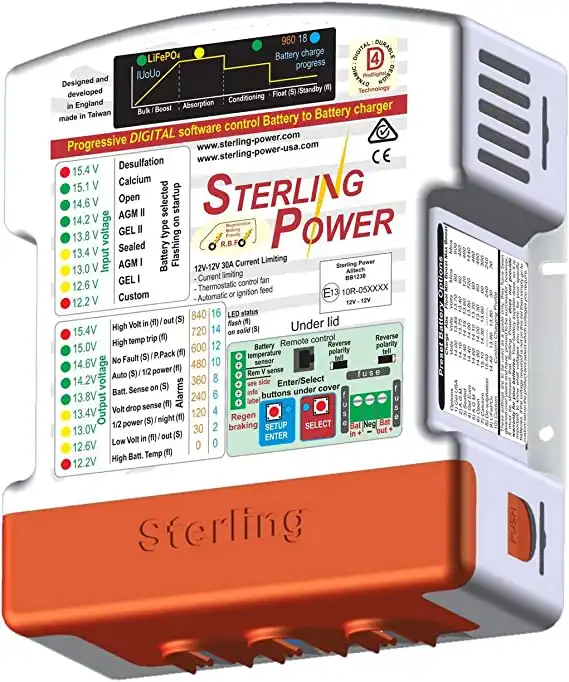
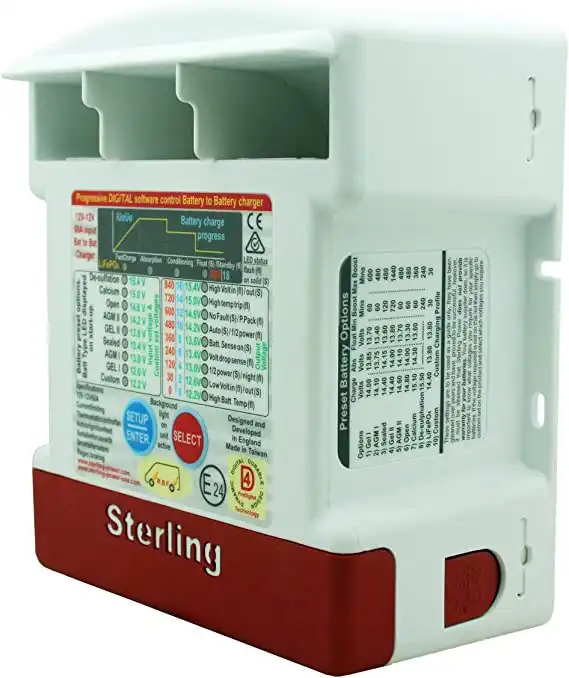
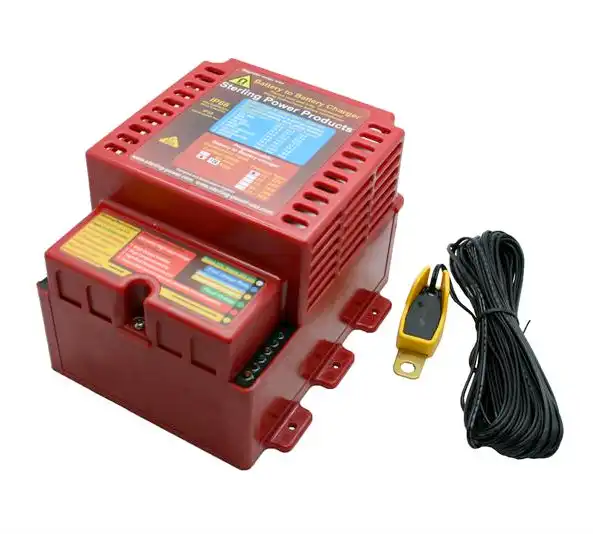
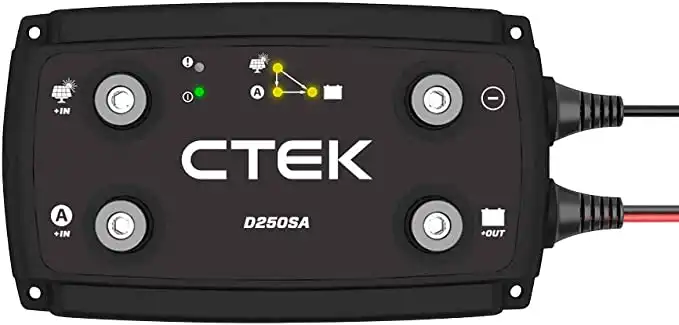
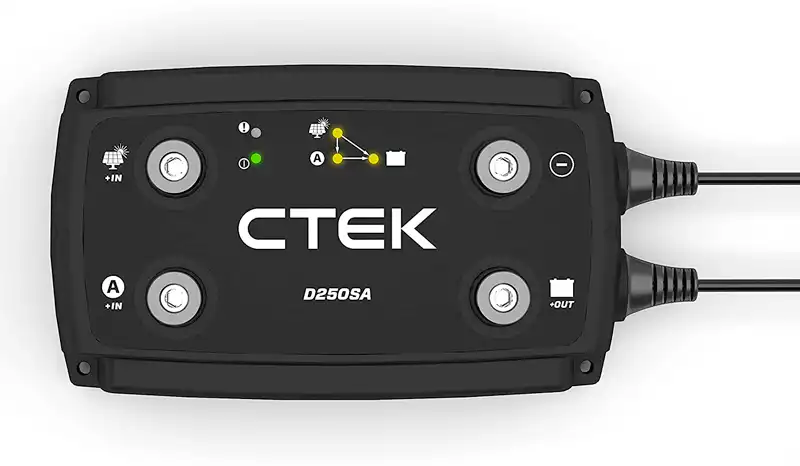
Hi
I’d just like to say thanks for mentioning our B2B charger . You were correct that our charger has never really been used in the us but our charger is a very rugged device and we hope to sell it in the US in the future . If you ever need / want any electrical/electronics advice as I’m a fairly competent electronics engineer and have been involved in quite a variety of electrical /electronic systems .
Thanks again Jonathan
Thanks for the offer, Jonathan! Your Ablemail charger is frequently recommended on some of the UK/international forums we visit and seems to be well regarded by the experts which is why we felt it worth mentioning. We are always looking for expert feedback on our site – especially with electrical systems – so we will most likely reach out when we are in position for advice.
-Ian
Hi I have a question I am struggling to find an answer to. My alternator says 24v 10/35a. Would a 30a b2b charger be too much of a strain.on the alternator please?
I am trying to charge a power bank that I built with NCR18650 Li-ion batteries (3s 10P) 12v 400 Wh. I can charge it with AC charger or via solar using an MPPT.
Question: rather than using a B2B charger could I feed the starter battery to the MPPT input?
Wouldn’t the MPPT handle 12v DC from the starter battery the same way it would handle it from the solar panel?
I’m not an engineer and I’m sure I must be missing something.
Please advise,
Dale
Dale,
Have you bought the MPPT yet? If not, you could consider getting the RedArc 40A B2B charger, which accepts starter voltage as well as solar voltage. It can also be custom programmed to charge Lithium chemistries.
It’s not the best thing to plug an alternator into a solar MPPT. Much of what a MPPT controller does is tracking the solar harvest right to the edge of voltage collapse point. That said, it would work in theory as long as you have a manual switch between the two system (solar and alternator). You you can’t connect both to the controller at once because then you’d be getting the high voltage of your solar panels connected directly to your starter battery! 12V panels can put out 18V or more in full sunlight which would ruin the starter battery quickly.
Redarc 40A B2B: https://redarcelectronics.com/products/dual_input_40a_in-vehicle_dc_battery_charger
Ian:
Thank you for your reply.
I have the Victron BlueSolar 75/15 MPPT Charge Controller – 15 Amps / 75 Volts. About $90 from Amazon.
I would be using the solar only when stopped and the starter battery only when driving.
I have an isolator from a previous dual battery build in my Jeep. I’m thinking that I can run wiring from the starter battery to the isolator and then to the mppt.
Thanks for the info on the Redarc. However their literature indicates that it charges LiFePO4 lithium batteries. My batteries are Li-ion lithium.
From my correspondence with TecMate about their OptiMATE DC to DC charger, charging LifePO4 and charging Li-ion is different and a LifePO4 charger will not charge Li-ion.
It seems to me that as long as I have the starter battery isolated the worse case scenario is that I blow the fuse on the mppt charge controller. What do you think? Am I missing something?
Thanks again, Ian, for your input.
Dale
Have there been any issues where the vehicle’s own charging algorithms/circuits get confused/panicked by the mystery draw of the B2B charger?
Hi i just bought a van and eventually want to buy a solar set up that charges 2 deep cycle batts but also i want to have my van alternator charge them as well when i drive. First i was thinking with my budget to buy the batts and the equipmwnt i need to connect and charge from the vehicle. Later on with my budget permitting i would add the solar. Any advice?
That’s the way that we would do it too. Depending on your budget, you can get the CTEK unit which will do both and does it with a full multi stage charge, that way when you want to hook up solar down the road you just need the panels.
With this method, you’ll definitely want to keep an eye on the battery health (voltage reading), as you can ruin hundreds of dollars worth of batteries if you’re hard on them, which does no good down the road.
Hi! Great article, thank you for sharing all this info!
I have a question : do you know if it’s possible to plug both a MPPT output and a B2B output at the same time on a battery bank? Will the MPPT adjust it’s battery voltage correctly, or both devices will fight to impose a specific charging voltage? I have the Sterling BB1260 which will draw some current from my alternator, and 40amp EPSolar MPPT that’s connected on a 400W solar panel (48V).
The other option I was considering is plugging both outputs to a switch, so I could choose between one or the other device connecting the battery. But I would prefer to combine them so I could charge faster and not bothering about turning the switch! Thank you for your help!
Phil
Thanks for posting this useful info about B to B chargers.
I run a truck camper that ‘charges’ via a solenoid and looong wire.
The converter in the camper will charge the batts when plugged in, but provides a constant 13.6 volts which is not sufficient to replenish a deeply discharged battery overnight, so I have been looking at charging solutions.
Rather than buy a good quality multistage charger or replacing the converter with a multistage charging capability, I wonder if the existing converter ( constant 13.6 volts) could be used to drive one of these good quality B to B chargers when in a powered campground. This would allow a proper charger at absorption voltage without tearing out the converter and have the added bonus of upgrading my solenoid/wire charging system.
Do you see any problem with this?
Renogy now also offers a B2B charger that we use on our bike repair truck!
Which is the easiest to use and set up for a beginner the B2B or the Battery Isolator I read both and is a little confusing on which to select, for someone just starting out with no electrical experience at all?
Thank you
For a beginner on a budget, a battery isolator is the easiest and lowest cost solution to install.
Thanks for your very informative website. I am just starting my weekender van build (ford transit high roof, LWB). Here in Australia most off grid systems in campervans, caravans, camper trailers etc use a B2B charger which is an MPPT and DCDC charger combined into 1 unit. I see on your website Redarc gets a mention (which is considered to be a very reputable brand in Australia). Another reputable company which is leading the way in Lithium setups (but can be used for AGM also) is a company called Enerdrive ( enerdrive.com.au ) They are the only company that I know of that have a complete range of products including batteries, dcdc/mppt and shore power chargers, inverters etc. Many of the high quality RV, caravan companies in Australia are using their complete systems. Both Redarc and Enerdrive are very reputable brands and seem to operate well in Australia’s harsh environments where travellers maybe off grid for long periods. I am not affiliated with either company but I only mention their products as they seem to be less cumbersome than having a seperate MPPT and B2B charger in a vanbuild electrical system. I am sure they would be keen to add North America and Europe to their list of customers.
I am in the middle of a van build and was considering an isolation switch to charge my batteries while driving but have been thinking a B2B charger would be a better option. I currently have 3-100w panels on the roof, connected to an outback flexmax 60 charge controller that is charging 2- renogy 170ah Li ion batteries. From what I have been reading here it would have been better to go with a B2B charger with MPPT capabilities but that is not what I have. How would I add a B2B charger to this setup? I have not bought an inverter yet, is there a device that I should be looking at that will save me from saying, ‘oops, I guess I should have gone that way’? This has been a wonderful learning experience, thanks for all the great advice, I’m clearly going to have to do this again 🙂
I am looking for a product recommendation. I have a 12v FLA GC-2 battery bank in my MH charged primarily by a 620 watt lifted solar array, with a generator/converter back-up. I would like to add a supplemental battery to battery charger to convert from a 14kwh LiFePo-4 48v nominal (16s) battery bank to occasionally charge my 12v FLA bank. Can you recommend an device to accomplish this? Thanks for your help!
Has anyone tried the new Renogy DCC50S 12V 50A DC Board Battery Charger with MPPT? Are there any other products other than the CTEK that combine a DC to DC ( B2B ) with an MPPT at a reasonable price?
I have a B2B unit and it charges my leisure batteries well. I wonder though … does the B2B condition the batteries and maintain them in the same way as perhaps an eight stage battery conditioner would? Any advice would be welcomed.